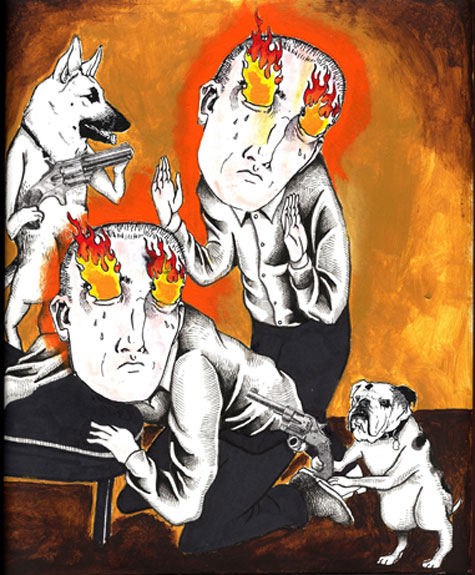
DARK Schaff's Monday Morning, Going to Work.
|
An often overlooked factor of Providence's underground art scene that flourished in the decade bookending the start of the millennium was the central place of the zine. The artists of Fort Thunder, the Hive Archive, Dirt Place, and other local crazy collectives may now be best known for their screenprinted posters and their rock and roll, but their self-produced books — mostly photocopied collections of comics, drawings, or collages plus screenprinted covers — were one of the first ways (along with the music) that word of the glorious stuff going on here got out.

So "Book As Post Modern Medium (The Book Show)" at 5 Traverse gallery (5 Traverse Street, Providence, through June 27) is a welcome sampling of the wealth of arty books being made locally, with cameos by some of these underground collective folks as just one example. 5 Traverse's Jesse Smith and Maya Allison spotlight five artists in the front room, then create a library of some 30 more in a second room (including picks by Brent Legault of Ada Books).
William Schaff collects three picture stories — drawn in his signature precise obsessive black-and-white linework — in Monday Morning, Going to Work, a limited-edition book published by the gallery. In one tale, a couple is all lovey-dovey couple until hands with knives sprout from their mouths and they stab each other. It's all deliciously, relentlessly gloomy, so seeing a lot of Schaff's stuff at once numbs its effect. But if you don't exceed recommended doses, Schaff is convincing as a punk Hieronymus Bosch, complete with dark Christian angst.
Jessica Deane Rosner's The Diary Project, also published by 5 Traverse, takes off from a diary she lost in 1986 and was miraculously returned to her in 2000. She photocopied pages and then drew over them. Unfortunately, the results aren't as amazing as the backstory — the diary writing is mundane (brief jottings on awkward encounters with friends, lists of things to do) and the drawings (cat-head people, butterflies, Celtic-ish patterning) feel fussy.
Lately Jacqueline Ott has been making terrific drawings of kaleidoscoping patterns of pinwheel shapes. She fills two books here with similar motifs (one per page), but the images are less complex and correspondingly less dazzling. Jonathan Bonner (Ott's husband) contributes an amusingly goofy photographic flip book of a long tongue rolling out of a trunk. Allison Paschke draws gold faux cuneiform on sheets of tissue pinned to a porcelain rectangle hung on the wall. It's really a precious sculpture, not a book at all.
Which raises the question: Why make art books? Except for Schaff (who has made comics) and Bonner (who dabbled in books in his recent concrete poetry pieces), these artists are not known for books. Their tomes feel like larks for the show.
The second room features artists for whom bookmaking has been more vital to their output, and the books feel correspondingly more . . . well, necessary. Christopher Paul Kelley's Russian Find Book is a one-of-a-kind book packed with quick drawings and collages that radiate an unstoppable need to create. Michael Bizon obsessively blacks out all the text in a teenybopper magazine and covers faces in designs resembling strange masks. It's mysterious, funny, and a bit creepy.
Other artists tap books as a time-tested way of packaging information. Dan Wood wittily, insightfully collects photographs of porta-potties at the 1995 Million Man March. Melissa Pace cuts into an old math text exposing 3D layers of magical geometric diagrams.
A number of the artists arrive at books by way of comics. James McShane's delightful The Watery Part of the World is thick little book about visiting a beach house. It's drawn in a casual, minimalist style, much like cartoonist John Porcellino. Fort Thunder co-founder Brian Chippendale's Galactikrap 2 is a photocopied comic with screenprinted cover about weird outer space encounters. Former Dirt Palace resident Jo Dery's Quietly Sure — Like the Keeper of a Great Secret is filled with brief, mystical, poetic, earthy fairy tales. Paper Rad's Cartoon Workshop/Pig Tales features goofball rainbow stoner fantasies.
For many of these artists, books are a do-it-yourself way of getting their work out. Their bookmaking also often reflects a desire to create art that is more affordable (because it's produced in multiples), more accessible, more humble. You might say they're books as an anti-fine art medium.
Read Greg's blog @ gregcookland.com/journal.